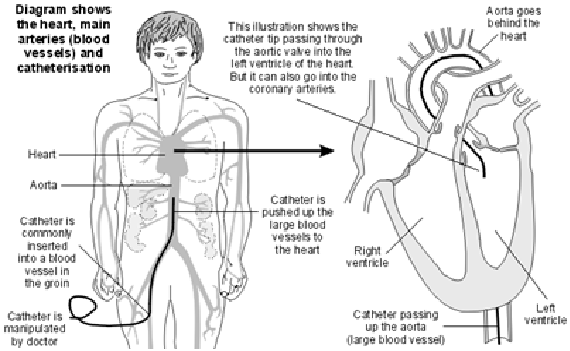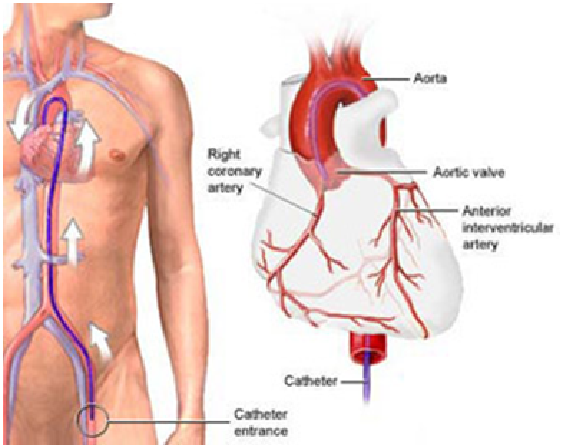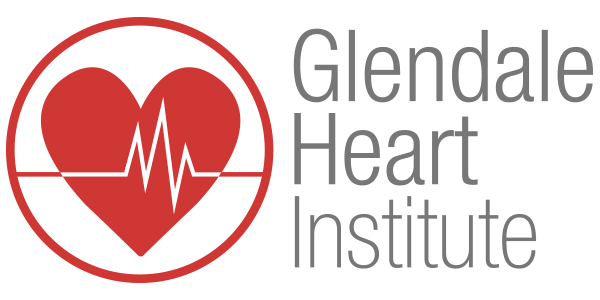Cardiac catheterization and angiography are tests in which catheters (hollow tubes) are placed into the heart in order to evaluate the anatomy and function of the heart and surrounding blood vessels. So much useful information can be obtained from these tests that they are performed in virtually all patients being considered for bypass surgery or angioplasty and stenting.
How is a catheterization performed?
The patient is brought to the catheterization laboratory and placed on a special examination table. After local anesthesia is given, a catheter is inserted into blood vessels in the groin, arm, or neck. (The catheter is inserted either through a small incision, or by means of a needle-stick. Sometimes, catheters are inserted from more than one site.) The catheter is advanced through the blood vessels to the heart.
How is a catheterization performed?
The patient is brought to the catheterization laboratory and placed on a special examination table. After local anesthesia is given, a catheter is inserted into blood vessels in the groin, arm, or neck. (The catheter is inserted either through a small incision, or by means of a needle-stick. Sometimes, catheters are inserted from more than one site.) The catheter is advanced through the blood vessels to the heart.

Once in the heart, the catheter can be maneuvered to various locations within the heart, and the pressures within various chambers of heart are measured.

Blood samples can be withdrawn from different locations in order to measure the amount of oxygen in the blood (unusual variations in blood oxygen can signal a “shunt,” or abnormal blood flow within the heart, often caused by congenital heart defects.) Finally, by injecting dye through the catheter while a series of rapid x-ray images is recorded, “movies” can be made of the blood flowing through the cardiac chambers, or the through the blood vessels surrounding the heart – a procedure know as angiography (also called arteriography).
Once the procedure is completed, the catheter(s) are removed. Bleeding is controlled by placing pressure on the catheterization site for 30 – 60 minutes.
What kinds of heart disease can catheterization and angiography help to evaluate?
Cardiac catheterization and angiography can reveal vital information about overall cardiac function, about the function of the individual cardiac chambers, about the cardiac valves (whether they are too narrow (stenosis) or too leaky (regurgitation)), congenital heart defects, and about the location and severity of blockages in the coronary arteries (the arteries that supply blood to the heart muscle).
Once the procedure is completed, the catheter(s) are removed. Bleeding is controlled by placing pressure on the catheterization site for 30 – 60 minutes.
What kinds of heart disease can catheterization and angiography help to evaluate?
Cardiac catheterization and angiography can reveal vital information about overall cardiac function, about the function of the individual cardiac chambers, about the cardiac valves (whether they are too narrow (stenosis) or too leaky (regurgitation)), congenital heart defects, and about the location and severity of blockages in the coronary arteries (the arteries that supply blood to the heart muscle).
What are some of the variations used with catheterization and angiography?
Cardiac catheterization is often used therapeutically, that is, to deliver treatment for various heart problems. Therapeutic catheterizations include procedures to dilate narrowed heart valves, procedures to close atrial septal defects (i.e., a hole in the wall separating the left and right atria), and of course, procedures to relieve blockages in the coronary arteries (angioplasty and stent placement).
What are the risks of having a catheterization or angiography?
Cardiac catheterization and angiography are relatively safe, but because they are invasive procedures involving the heart, several complications are possible. Nobody should have a cardiac catheterization unless there is a reasonable likelihood that the information gained from the procedure will be of significant benefit.
Minor complications of cardiac catheterization include minor bleeding at the site of catheter insertion, temporary heart rhythm disturbances caused by the catheter irritating the heart muscle, and temporary changes in the blood pressure.
More significant complications include perforation of the heart wall (causing a life-threatening condition called cardiac tamponade), sudden blockage of a coronary artery (leading to a heart attack), extensive bleeding, stroke, or an allergic reaction to the dye used in angiography.
Cardiac catheterization is often used therapeutically, that is, to deliver treatment for various heart problems. Therapeutic catheterizations include procedures to dilate narrowed heart valves, procedures to close atrial septal defects (i.e., a hole in the wall separating the left and right atria), and of course, procedures to relieve blockages in the coronary arteries (angioplasty and stent placement).
What are the risks of having a catheterization or angiography?
Cardiac catheterization and angiography are relatively safe, but because they are invasive procedures involving the heart, several complications are possible. Nobody should have a cardiac catheterization unless there is a reasonable likelihood that the information gained from the procedure will be of significant benefit.
Minor complications of cardiac catheterization include minor bleeding at the site of catheter insertion, temporary heart rhythm disturbances caused by the catheter irritating the heart muscle, and temporary changes in the blood pressure.
More significant complications include perforation of the heart wall (causing a life-threatening condition called cardiac tamponade), sudden blockage of a coronary artery (leading to a heart attack), extensive bleeding, stroke, or an allergic reaction to the dye used in angiography.
Cardiac Specialty Care
• Structural Heart Disease
• TAVR
• CardioMEMS (Heart Failure)
• PFO Closure
• TAVR
• CardioMEMS (Heart Failure)
• PFO Closure
• Coronary Intervention
• Complex Higher-Risk (And Indicated) Patients (CHIP) Angioplasty
• Atherectomy
• Impella and ECMO Support
• Complex Higher-Risk (And Indicated) Patients (CHIP) Angioplasty
• Atherectomy
• Impella and ECMO Support
• Peripheral Angioplasty
• Varicose Vein Treatment (Venous Ablation)
• DVT thrombectomy - IVC filter
• Carotid Stenting
• Varicose Vein Treatment (Venous Ablation)
• DVT thrombectomy - IVC filter
• Carotid Stenting
• Rhythm Management
• Pacemaker
• Holter Monitoring
• Exercise Stress Test
• Echocardiography
• Nuclear Stress Test
• Enhanced External Counterpulsation (EECP)
• Pacemaker
• Holter Monitoring
• Exercise Stress Test
• Echocardiography
• Nuclear Stress Test
• Enhanced External Counterpulsation (EECP)
